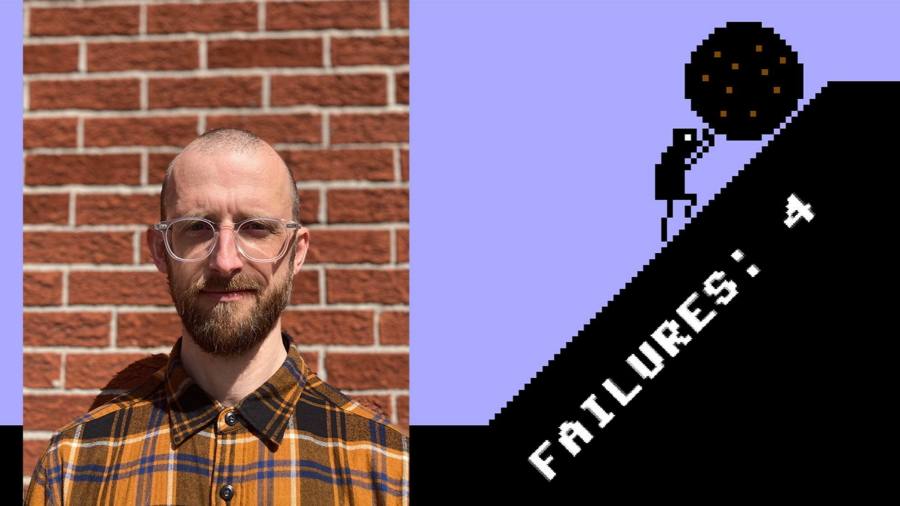Receive free Gaming updates
We’ll send you a myFT Daily Digest email rounding up the latest Gaming news every morning.
Pippin Barr might just be the most prolific solo game developer in the world. Since 2011 he has released a baffling 81 of them — and while many are just snapshots or thought experiments, what they lack in length and pixel count they more than make up for in provocation and wit.
Barr is a comedian (he’s also, at 44, associate professor in the department of design and computation arts at Montreal’s Concordia University), but his stage is virtual, his jokes are puzzles and his audience anonymous. Take Sisyphus, first released in 2011. Players, like the doomed king of Ephyra, must roll a large boulder up a hill until it inevitably tumbles back down, whereupon they start again. “It’s a joke about games and doing these pointless things over and over again that are not actually that difficult to do,” says Barr. “But you do it anyway because the game told you to.”
As much as developing games for the player, Barr is fascinated by the idea of creating something for the computer itself — such that he created a CPU Edition of Sisyphus that dispenses with human input altogether and leaves the computer (or its central processing unit) straining itself — on repeat, ad infinitum, until told otherwise — to enact the king’s punishment. The game — from the player’s perspective, in so far as there is one — is acknowledging the effort that the computer is putting in. “I like that idea of empathy that comes from the machine,” Barr says. “There’s something really poignant about seeing your computer try to do this impossible thing.”
Challenging both human and hardware is at the centre of Barr’s new book, The Stuff Games Are Made Of, an entertaining unpacking of the systems and quirks behind game design, illustrated by the oddities of his own works and a smattering of video game history. His background in computer science, the subject in which he completed his PhD at Victoria University of Wellington, New Zealand (he was born in New Zealand), informs his expertise, but this is no dusty academic slog. And nor are his creations.
“I playtest my games with my parents,” he says. “They’re not gamers, but I feel like if they can play my games and get a sense of what’s going on, then that’s mission accomplished.”
Above all, Barr is interested in playing games differently. On Gamething, the podcast he co-hosts with writer David Wolinsky, the current focus is speedrunning — the practice of trying to make it through a game as quickly as possible; The Stuff Games Are Made Of explores the process of iterating on and deconstructing the many gameplay tropes that we take for granted, and the games themselves encourage deeper thinking about the ways we play.
In Pongs, for example, Barr set out to find out how he could distort the blocky 1972 classic by producing 36 variants on its rules. So Trace Pong leaves a line behind the path of the ball, creating patterns on the screen. Unfair Pong sees one player with a paddle 24 times as big as the other and scoring five times as many points. My favourite, Viennese Pong, asks the player if they are currently in Vienna — if they answer no (for the game imagines itself taking place in the Austrian capital), the application promptly quits.
The results of such experimentation are amusing, disconcerting and disruptive. “You need someone — and usually it’s artists of one stripe or another — to push in really different directions and not care if it works,” says Barr. “I think with games the real opportunity is the way that you can do that experiment yourself but have the player experience it.”
Perhaps the most successful of Barr’s experiments has been The Artist Is Present, a game inspired by Marina Abramović’s 2010 performance piece. Just as the Serbian artist sat silently with visitors to New York’s Museum of Modern Art — one at a time, eight hours a day, over the course of almost three months — so too must the player face their own test of endurance by joining the queue for the performance.
This is easier said than done: for one, the museum is only open during its usual hours, and will not let you in if your computer’s clock reads outside of these. Then there’s the queue itself: the game randomly allocates a duration to the virtual visitors ahead of you — each visitor will spend anything between two minutes and eight hours with Abramović. And think again about leaving your computer idle while you wait: if you fail to shuffle forward within 30 seconds of the queue moving, you’ll be jostled from behind and have to start over. Barr himself spent five hours queueing in his own game, trying not to get too distracted by background entertainment and calls of nature. “Trips to the bathroom were an agony of anxiety,” he recalls. “The West Wing was a blur. I burned my omelette.”
You’ll have to endure the queue if you want to find out what happens when you get to the front. Fortunately all of Barr’s games are available for free on his website. That’s not to say that they’re not worth anything, just that accessibility fits his philosophy of wanting to see people play — particularly those who wouldn’t normally spend money on games.
As for where his priceless experiments will take him next, his library of 81 is about to become 82: “I made Super Mario Nothing this morning,” he says, offhand, of an empty game file he plans to release shortly, an artistic counter to the escalating Land, World and Galaxy suffixes of the Super Mario titles. Another punchline for his own ever-expanding universe.
‘The Stuff Games Are Made Of’ is published by The MIT Press
Read the full article here



